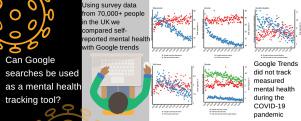Journal of Affective Disorders ( IF 4.9 ) Pub Date : 2021-07-09 , DOI: 10.1016/j.jad.2021.06.086 Duleeka Knipe 1 , David Gunnell 2 , Hannah Evans 3 , Ann John 3 , Daisy Fancourt 4

|
Background
Google Trends data are increasingly used by researchers as an indicator of population mental health, but few studies have investigated the validity of this approach during a public health emergency.
Methods
Relative search volumes (RSV) for the topics depression, anxiety, self-harm, suicide, suicidal ideation, loneliness, and abuse were obtained from Google Trends. We used graphical and time-series approaches to compare daily trends in searches for these topics against population measures of these outcomes recorded using validated self-report scales (PHQ-9; GAD-7; UCLA-3) in a weekly survey (n = ~70,000) of the impact COVID-19 on psychological and social experiences in the UK population (21/03/2020 to 21/08/ 2020).
Results
Self-reported levels of depression, anxiety, self-harm/suicidal ideation, self-harm, loneliness and abuse decreased during the period studied. There was no evidence of an association between self-reported anxiety, self-harm, abuse and RSV on Google Trends. Trends in Google topic RSV for depression and suicidal ideation were inversely associated with self-reports of these outcomes (p = 0.03 and p = 0.04, respectively). However, there was statistical and graphical evidence that self-report and Google searches for loneliness (p < 0.001) tracked one another.
Limitations
No age/sex breakdown of Google Trends data available. Survey respondents were not representative of the UK population and no pre-pandemic data were available.
Conclusion
Google Trends data do not appear to be a useful indicator of changing levels of population mental health during a public health emergency, but may have some value as an indicator of loneliness.
中文翻译:

谷歌趋势是一个在公共卫生紧急情况下追踪精神和社交困扰的有用工具吗?时间序列分析
背景
研究人员越来越多地使用谷歌趋势数据作为人口心理健康的指标,但很少有研究调查这种方法在公共卫生紧急情况下的有效性。
方法
抑郁、焦虑、自残、自杀、自杀意念、孤独和虐待等主题的相对搜索量 (RSV) 是从 Google 趋势中获得的。我们使用图形和时间序列方法,将这些主题的搜索每日趋势与在每周调查中使用经过验证的自我报告量表(PHQ-9;GAD-7;UCLA-3)记录的这些结果的人口测量结果进行比较(n =约 70,000)的 COVID-19 对英国人口心理和社会经历的影响(2020 年 3 月 21 日至 2020 年 8 月 21 日)。
结果
在研究期间,自我报告的抑郁、焦虑、自残/自杀意念、自残、孤独和虐待水平有所下降。 Google 趋势上没有证据表明自我报告的焦虑、自残、虐待和 RSV 之间存在关联。谷歌主题抑郁症和自杀意念 RSV 的趋势与这些结果的自我报告呈负相关(分别为p = 0.03 和p = 0.04)。然而,统计和图形证据表明,自我报告和谷歌搜索孤独感( p <0.001)是相互跟踪的。
局限性
没有可用的 Google 趋势数据的年龄/性别细分。调查受访者并不代表英国人口,也没有大流行前的数据。
结论
谷歌趋势数据似乎并不是公共卫生紧急情况下人口心理健康水平变化的有用指标,但作为孤独感的指标可能具有一定的价值。











































 京公网安备 11010802027423号
京公网安备 11010802027423号